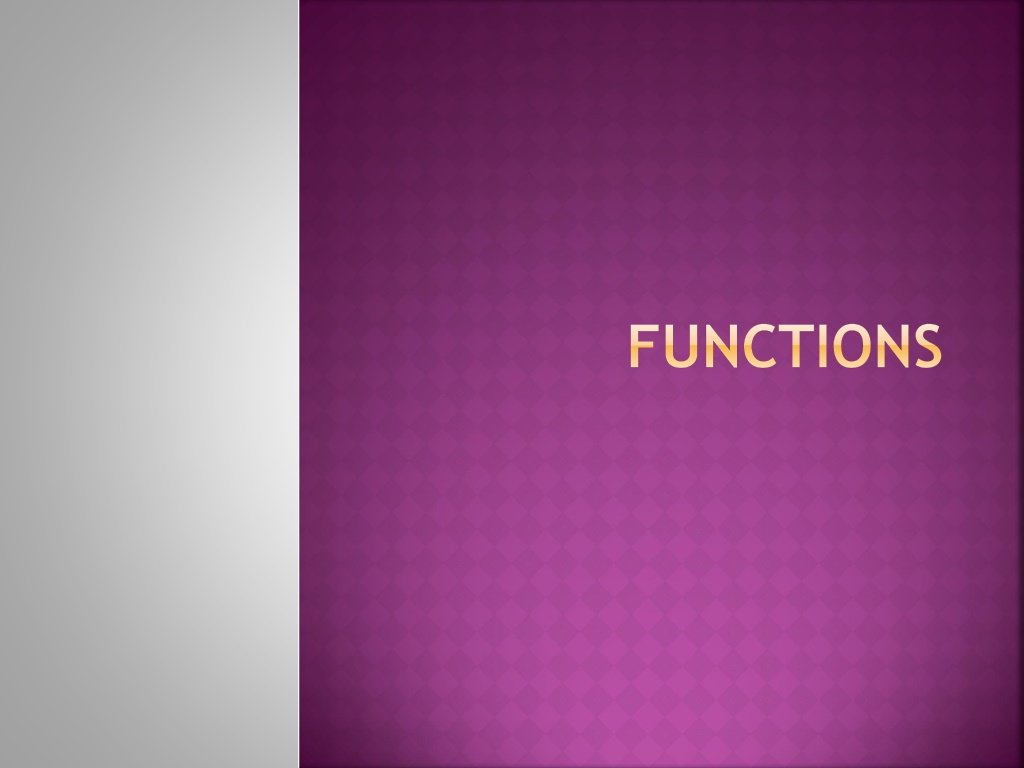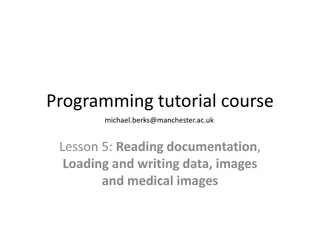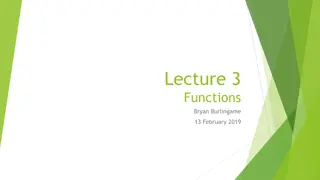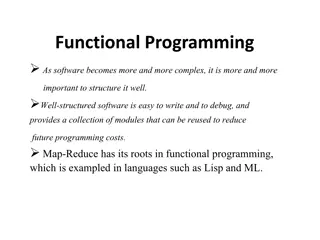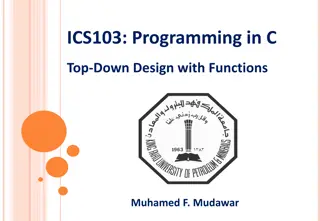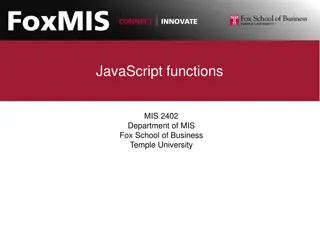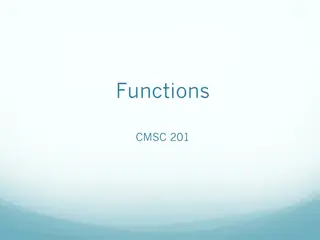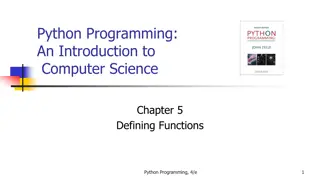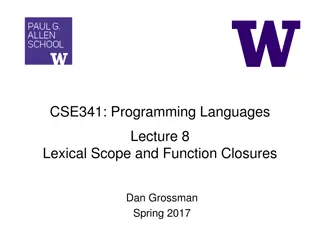Understanding Functions in Programming
Functions play a crucial role in programming by enabling modularity, code sharing, and top-down design approach. This content covers the definition, manipulation, naming conventions, types, and examples of functions in programming, along with insights from Dr. Soha S. Zaghloul.
Download Presentation

Please find below an Image/Link to download the presentation.
The content on the website is provided AS IS for your information and personal use only. It may not be sold, licensed, or shared on other websites without obtaining consent from the author. Download presentation by click this link. If you encounter any issues during the download, it is possible that the publisher has removed the file from their server.
E N D
Presentation Transcript
1. WHY FUNCTIONS? Modularity: break up the problem into sub- problems. Top-down design approach: when attempting to solve a sub-problem at one level, new sub- problems arise at a lower level. Code sharing: In big projects, the coding is assigned to different people. The code is then assembled in a single code. This is impossible to achieve without the concept of functions. Create libraries: in the same way there are stdio.h and string.h libraries, you may create your own library. Dr. Soha S. Zaghloul Dr. Soha S. Zaghloul 2 2
2. FUNCTIONS MANIPULATION In order to deal with functions, we have to know the following: Definition: writing the statements of the function Prototypes: functions declaration Calling: how to call a function Dr. Soha S. Zaghloul Dr. Soha S. Zaghloul 3 3
3. FUNCTIONS DEFINITION Any function has a name. Any function has a type. A function may have arguments. A function has one or more statements. The following function calculates the area of a circle: double Circle (double radius) { double PI = 3.14; double area; area = 3.14 * radius * radius; return (area); } Dr. Soha S. Zaghloul Dr. Soha S. Zaghloul 4 4
4. FUNCTION NAME The name of a function obeys the same rules as those of an identifier. Therefore, the following function names are NOT accepted: Function name Circle-Area 1Area continue Reason Hyphen is not allowed Should start with a letter Reserved word In the previous example, Circle is the function name. Dr. Soha S. Zaghloul Dr. Soha S. Zaghloul 5 5
5. FUNCTION TYPE A function returns a single value at most to the main program. The type of the function is the same as that of the returned type. If the function does not return any value, then the type is void . Dr. Soha S. Zaghloul Dr. Soha S. Zaghloul 6 6
6. FUNCTION TYPE EXAMPLE (1) double Circle (double radius) { double PI = 3.14; double area; area = 3.14 * radius * radius; return (area); } In the above example, the function returns the area of the circle. Since area is defined in the function as double, then the function is of type double. Dr. Soha S. Zaghloul Dr. Soha S. Zaghloul 7 7
7. FUNCTION TYPE EXAMPLE (2) void PrintLetter (char letter) { int i; for (i= 1; i<= 10; i++) printf ( /n , letter); } The above function should print letter ten times on ten lines. Since it does not return anything, then the type of the function is void. No return statement should be associated with a function of type void. Dr. Soha S. Zaghloul Dr. Soha S. Zaghloul 8 8
8. FUNCTION ARGUMENTS The function arguments are the variables through which values are transferred to the function from the main program (or from another function) to work with. There is no restriction on the number of arguments. We may have no arguments. Each argument has a name and is preceded by its type. The order of arguments listing is relevant. This will be more illustrated when we discuss function calling. Dr. Soha S. Zaghloul Dr. Soha S. Zaghloul 9 9
8. FUNCTION ARGUMENTS (CONTD) There is NO relation between the type of function and the number and/or type of arguments. For example: A void function may have arguments; A double function may have no arguments; An int function may have an argument of type char; and so on The arguments are also sometimes called the parameter list of a function. Dr. Soha S. Zaghloul Dr. Soha S. Zaghloul 10 10
9. FUNCTION ARGUMENTS EXAMPLE (1) double Circle (double radius) { double PI = 3.14; double area; area = 3.14 * radius * radius; return (area); } In the above example, the parameter list consists of one variable radius, which is of type double. Note that radius is not declared within the function. Dr. Soha S. Zaghloul Dr. Soha S. Zaghloul 11 11
10. FUNCTION ARGUMENTS EXAMPLE (2) double Average (double sum, int count) { return (sum/count); } In the above example, the parameter list consists of two variables sum (of type double), and count (of type int) Arguments are separated by commas. Note that the return statement may include an arithmetic operation. Dr. Soha S. Zaghloul Dr. Soha S. Zaghloul 12 12
11. FUNCTION ARGUMENTS EXAMPLE (3) void Menu(void) { printf ( +: Addition \n ); printf ( -: Subtraction \n ); printf ( *: Multiplicaiton \n ); printf ( /: Division \n ); printf ( %: Modulus \n ); } The above function contains no arguments, and is of type void. It is called to display the shown menu. Dr. Soha S. Zaghloul Dr. Soha S. Zaghloul 13 13
12. FUNCTION STATEMENTS The function structure is similar to the main program, which is actually a function. Therefore, the structure is as follows: Declaration part if needed. Refer to slide 13. Initialization part if needed. Processing part if needed. Return statement for non-void functions Dr. Soha S. Zaghloul Dr. Soha S. Zaghloul 14 14
13. FUNCTION STATEMENTS EXAMPLE (1) int Sum (int num1, int num2, int num3) { int total; total = num1 + num2 + num3; return (total); } The above example could be written as: int Sum (int num1, int num2, int num3) { return (num1 + num2 + num3); } The above function has only one return statement. There is no declaration, initialization, nor processing. Dr. Soha S. Zaghloul Dr. Soha S. Zaghloul 15 15
14. FUNCTIONS DEFINTION 1. 2. 3. 4. 5. 6. 7. 8. 27. double CircleArea (double radius) 28. { 29. ------ 30. } // end CircleArea 31. // end of program #include <stdio.h> int main (void) { ------ ------ return (0); } // end main // start define all functions Functions are defined after the end of the main function Dr. Soha S. Zaghloul Dr. Soha S. Zaghloul 16 16
15. FUNCTIONS PROTOTYPES 1. 2. 3. #include <stdio.h> // Function prototype double CircleArea(double radius); 4. 5. 6. 7. 8. 9. 10. // start define all functions 11. double CircleArea (double radius) 12. { 13. ------ 14. } // end CircleArea 15. // end of program int main (void) { ------ ------ return (0); } // end main In addition, a prototype of the function should be written before the main function. Dr. Soha S. Zaghloul Dr. Soha S. Zaghloul 17 17
15. FUNCTIONS PROTOTYPES (CONTD) Note that the function prototype ends with a semicolon, while the function header does not. The program execution starts at the main function; then each function is executed when called. Dr. Soha S. Zaghloul Dr. Soha S. Zaghloul 18 18
16. FUNCTION CALL EXAMPLE (1) 1. 2. 3. #include <stdio.h> // Function prototype double CircleArea(double radius); // FUNCTION PROTOTYPE 4. 5. 6. 7. 8. 9. 10. printf ( Area of circle = %f , circle); 11. return (0); 12. } // end main int main (void) { double circle, r; printf ( Enter circle radius> ); scanf ( %f , r); circle = CircleArea( r ); // FUNCTION CALL 13. // start define your functions 14. double CircleArea (double radius) 15. { 16. double area; 17. area = 3.14 * radius * radius; 18. return (area); 19. } // end CircleArea 20. // end of program // FUNCTION HEADER AND DEFINITION // RETURN VALUE Dr. Soha S. Zaghloul Dr. Soha S. Zaghloul 19 19
17. FUNCTION CALL In line 9 of the previous example, we call the function CircleArea:- The value returned by a function (area) is stored in a variable declared in the main function (circle). The type of the declared variable should be the same as that of the function (double). The variable used in the actual argument list (r) replaces the formal parameter (radius). The actual argumentshould also be declared in the main function. It should be the same type as the formal parameter. In addition, r should have a value before calling the function. Note that the types of the arguments are not written when calling the function in the main program. Be sure that the number and types of arguments in the prototype, the function call, and the function header are the same. Dr. Soha S. Zaghloul Dr. Soha S. Zaghloul 20 20
18. MULTI-ARGUMENT FUNCTIONS When using multiple-argument functions, you must be careful: To include the correct number of arguments in the function prototype, function call, and function header. Also, the order of the actual arguments used in the function call must correspond to the order of the formal parameters listed in the function prototype or heading. Dr. Soha S. Zaghloul Dr. Soha S. Zaghloul 21 21
19. MULTI-ARGUMENTS FUNCTIONS EXAMPLE (1) 1. 2. 3. #include <stdio.h> // Function prototype int power(int num1, int num2); // FUNCTION PROTOTYPE 4. 5. 6. 7. 8. 9. 10. } // end main int main (void) { int result; result = power (2, 5) ; // actual parameters result = power (5, 2); // actual parameters return (0); num1 = 2, num2 = 5 (ie 25 = 32) num1 = 5, num2 = 2 (ie 52 = 25) 11. // start define your functions 12. int power( int num1, int num2) // formal parameters 13. { 14. int i; 15. int product = 1; 16. for (i= 1; i< num2; i++) 17. product *= num1; 18. return product; 19. } // end power 20. // end of program Dr. Soha S. Zaghloul Dr. Soha S. Zaghloul 22 22
20. ZER0-ARGUMENT FUNCTIONS EXAMPLE (1) 1. 2. 3. #include <stdio.h> // Function prototype char DisplayMenu (void); // FUNCTION PROTOTYPE 4. 5. 6. 7. 8. 9. int main (void) { char option; option = DisplayMenu() ; return (0); } // end main // FUNCTION CALL 10. // start define your functions 11. char DisplayMenu (void) 12. { 13. char choice; 14. printf ( C: Area of a Circle \n ); 15. printf ( T: Area of a Triangle \n ); 16. printf ( S: Area of a Square \n ); 17. printf ( Enter your choice> ); 18. scanf ( %c , choice); 19. return (choice); 20. } // end DisplayMenu 21. // end of program // FUNCTION HEADER // returned value Dr. Soha S. Zaghloul Dr. Soha S. Zaghloul 23 23
21. ZERO-ARGUMENT FUNCTIONS EXAMPLE (1) 1. 2. 3. #include <stdio.h> // Function prototype char DisplayMenu (void); // FUNCTION PROTOTYPE 4. 5. 6. 7. 8. 9. int main (void) { char option; option = DisplayMenu() ; return (0); } // end main // FUNCTION CALL 10. // start define your functions 11. char DisplayMenu (void) 12. { 13. char choice; 14. printf ( C: Area of a Circle \n ); 15. printf ( T: Area of a Triangle \n ); 16. printf ( S: Area of a Square \n ); 17. printf ( Enter your choice> ); 18. scanf ( %c , choice); 19. return (choice); 20. } // end DisplayMenu 21. // end of program // FUNCTION HEADER // returned value Dr. Soha S. Zaghloul Dr. Soha S. Zaghloul 24 24
22. SELF-CHECK EXERCISE Write a complete modular program that displays a menu to perform the four mathematical operations (+, -, *, /). Each operation should be then computed in a separate function. Dr. Soha S. Zaghloul Dr. Soha S. Zaghloul 25 25
